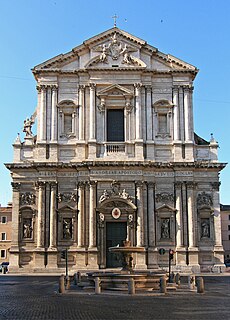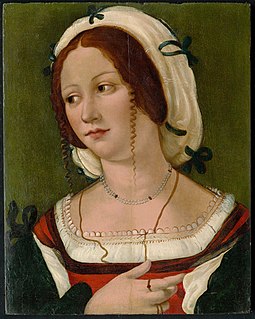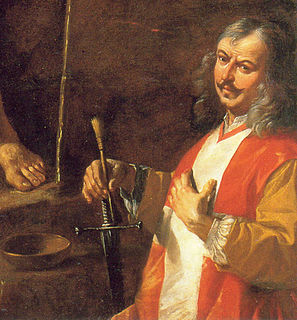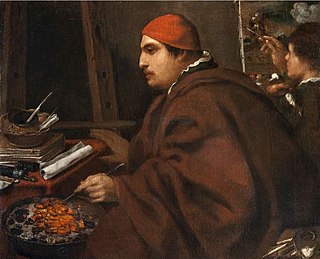Related Research Articles

Giovanni Francesco Barbieri, better known as Guercino, or il Guercino[ɡwerˈtʃiːno], was an Italian Baroque painter and draftsman from Cento in the Emilia region, who was active in Rome and Bologna. The vigorous naturalism of his early manner contrasts with the classical equilibrium of his later works. His many drawings are noted for their luminosity and lively style.

Sant'Andrea della Valle is a minor basilica in the rione of Sant'Eustachio of the city of Rome, Italy. The basilica is the general seat for the religious order of the Theatines. It is located at Piazza Vidoni, 6 at the intersection of Corso Vittorio Emanuele and Corso Rinascimento.
The School of Ferrara was a group of painters which flourished in the Duchy of Ferrara during the Renaissance. Ferrara was ruled by the Este family, well known for its patronage of the arts. Patronage was extended with the ascent of Ercole d'Este I in 1470, and the family continued in power till Alfonso II, Ercole's great-grandson, died without an heir in 1597. The duchy was then occupied in succession by Papal and Austrian forces. The school evolved styles of painting that appeared to blend influences from Mantua, Venice, Lombardy, Bologna, and Florence.

The Bolognese School or the School of Bologna of painting flourished in Bologna, the capital of Emilia Romagna, between the 16th and 17th centuries in Italy, and rivalled Florence and Rome as the center of painting. Its most important representatives include the Carracci family, including Ludovico Carracci and his two cousins, the brothers Agostino and Annibale Carracci. Later, it included other Baroque painters: Domenichino and Lanfranco, active mostly in Rome, eventually Guercino and Guido Reni, and Accademia degli Incamminati in Bologna, which was run by Lodovico Carracci. Certain artistic conventions, which over time became traditionalist, had been developed in Rome during the first decades of the 16th century. As time passed, some artists sought new approaches to their work that no longer reflected only the Roman manner. The Carracci studio sought innovation or invention, seeking new ways to break away from traditional modes of painting while continuing to look for inspiration from their literary contemporaries; the studio formulated a style that was distinguished from the recognized manners of art in their time. This style was seen as both systematic and imitative, borrowing particular motifs from the past Roman schools of art and innovating a modernistic approach.

Mattia Preti was an Italian Baroque artist who worked in Italy and Malta. He was appointed a Member of the Order of Saint John.

Luca Longhi was an Italian painter of the late-Renaissance or Mannerist period, active in and near Ravenna, where he mainly produced religious paintings and portraits.

Francesco Costanzo Catanio, was a painter of the Italian Baroque period, born and mainly active in Ferrara. He was variously known as Catanio, Cattani, Cattaneo, or Cattanio, sometimes without the forename Francesco.

Giuseppe Caletti or Calletti was an Italian painter and engraver of the Baroque period, active in Ferrara and Cremona. He often painted religious themes in a genre like dress and surroundings, including the theme of Bacchanalia like Titian.
Giovanni Francesco Braccioli was an Italian painter of the Baroque period, mainly active in Ferrara.
Alfonso Rivarola was an Italian painter of the Baroque period, active mainly in Ferrara, where he was born. He is also known as il Chenda because of an inheritance he received from someone with that name.

Giovanni Francesco Surchi was an Italian painter of the late-Renaissance period, active in Ferrara.
Matteo Zaccolini was an Italian painter, priest and author of the late Mannerist and early Baroque periods. He was a mathematical theorist on perspective. He is also called "Zacolini" and "Zocolino".

Francesco Naselli was an Italian painter of the Baroque period.

Jacopo Alessandro Calvi was an Italian painter and art critic who painted sacred and historical subjects in a late-Baroque style.
Cesare Mezzogori was an Italian painter, active in a Baroque style.

The Church of the Theatines (Teatini), also known as Santa Maria della Pietà is a Roman Catholic, Baroque-style church and monastery located on Corso della Giovecca, in central Ferrara, region of Emilia-Romagna, Italy.
Camillo Setti was an Italian painter, active in a Baroque style mainly in his native Ferrara.

Ferrara Charterhouse, of which the present Church of San Cristoforo alla Certosa was previously the monastic church, is a former charterhouse or Carthusian monastery built in Renaissance style, located on Piazza Borso 50 in Ferrara, Region of Emilia-Romagna, Italy. The monastery was suppressed in the time of Napoleon, but the church was reconsecrated in 1813 and remains in use. The site also accommodates a large municipal cemetery, which was established in 1813.

Chiesa di San Giovanni Evangelista Organ Case is a set of four tempera on canvas paintings produced by Moretto da Brescia, c. 1535. The inner sides show stories from the life of John the Baptist and scenes from the life of John the Evangelist. They now hang on the walls of the chancel of the church for which they were painted, San Giovanni Evangelista in Brescia.

Lamentation was a 1587-1590 oil on canvas painting by Annibale Carracci, destroyed with other Carracci works such as Danaë at Bridgewater House in May 1941 during the London Blitz. Prints and copies of it survive, the best being those by the Ferrara painter Francesco Naselli now in Mantua's city library.
References
- ↑ Dizionario storico degli uomini illustri ferraresi, by Luigi Ughi, page 85.
- ↑ Il costume antico e moderno, di tutti il popolo, Europe, volume nine, page 237.
- ↑ Oxford Index.